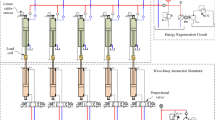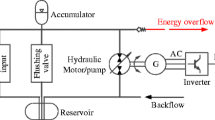Abstract
Wave energy is known to be a promising energy source for the goal of environmental protection and reducing dependence on fossil fuel sources. Hydraulic power-take-off (HPTO) is a key technology of wave energy converters which determines the energy recovery efficiency of the whole system. This paper presents a novel control strategy for HPTO to enhance the regenerated power and energy efficiency by using a suitable configuration of a variable displacement hydraulic motor and a generator. A control management strategy was designed to adjust the tilt angle of the hydraulic motor and the generator resistance load to maintain them working in the highest performance area under variable wave conditions. To verify the proposed system, a simulation model was built in AMESim software based on the previous experiment test bench configuration. Simulation results showed that by applying the proposed strategy, the generated energy increased during the working process. Compared with other control methods, the improvement of energy generation efficiency of the proposed control management method was approximately 10% higher in the low and medium wave conditions.











Similar content being viewed by others
Data Availability
Not applicable.
Code Availability
Not applicable.
Abbreviations
- \({E}_{h}\) :
-
Hydraulic energy (kJ)
- \({P}_{m}\) :
-
Pressure of the hydraulic motor (bar)
- \({Q}_{m}\) :
-
Flow rates through the hydraulic motor (lpm)
- \(D\) :
-
Displacement of the hydraulic motor (cc/rev)
- \({\omega }_{m}\) :
-
Rotational speed of the hydraulic motor (rpm)
- \({\eta }_{v}\) :
-
Hydraulic motor volumetric efficiency
- \({D}_{m}\) :
-
Maximum displacement of the hydraulic motor (cc/rev)
- \({E}_{m}\) :
-
Mechanical energy (kJ)
- \({T}_{m}\) :
-
Torque of the hydraulic motor (Nm)
- \({\eta }_{m}\) :
-
Hydraulic motor mechanical efficiency
- \({\Delta }p\) :
-
Pressure difference between two ports (bar)
- \({\eta }_{gen}\) :
-
Generated efficiency
- \({E}_{gen}\) :
-
Generated energy (kJ)
- \({\eta }_{tot}\) :
-
Overall efficiency
References
Drew, B., Plummer, A. R., & Sahinkaya, M. N. (2009). A review of wave energy converter technology. . Proc Inst Mech Eng Part A J Power Energy, 223, 887–902.
Jiang Y, Peng Y, Sun Y, Zong Z, Sun L. (2020). Design and testing of a mechanical power take-off system for rolling-type wave energy converter. Int J Pr Eng Man-Green Technol. https://doi.org/10.1007/s40684-020-00253-z
Dang, T. D., Phan, C. B., & Ahn, K. K. (2019). Modeling and experimental investigation on performance of a wave energy converter with mechanical power take-off. Int J Precis Eng Manuf-Green Technol, 6(4), 751–768.
Ha K, Truong H. V. A, Dang T. D, & Ahn K. K. (2020). Recent control technologies for floating offshore wind energy system: a review. Int J Precis Eng Manuf-Green Technol. https://doi.org/10.1007/s40684-020-00269-5
Kang, T. W., Kim, E. S., & Yang, H. I. (2021). Effects of dynamic motion and structural response of a semi-submersible floating offshore wind turbine structure under waves generated in a Hurricane environment. Int J Precis Eng Manuf-Green Technol,. https://doi.org/10.1007/s40684-021-00331-w
Atalay T, Yakut Y, Köysal Y, Özbektaş S, Bülbül H, Topaloğlu B (2021). Experimental and thermal analysis of solar thermoelectric system performance incorporated with solar tracker. Int J Precis Eng Manuf-Green Technol,. https://doi.org/10.1007/s40684-021-00341-8
Iraide, L., Jon, A., Salvador, C., de Iñigo Martínez, A., & Iñigo, K. (2013). Review of wave energy technologies and the necessary power-equipment. Renewable and Sustainable Energy Reviews, 27, 413–434.
Silvia, B., Adrià Moreno, M., Alessandro, A., Giuseppe, P., & Renata, A. (2013). Modeling of a point absorber for energy conversion in Italian seas. Energies, 6, 3033–3051.
Jusoh, M. A., Ibrahim, M. Z., Daud, M. Z., Albani, A., & Yusop, Z. M. (2019). Hydraulic power take-off concepts for wave energy conversion system: a review. Energies, 12, 4510.
Binh, P. C., Tri, N. M., Dung, D. T., Ahn, K. K., Kim, S. J., & Koo, W. (2016). Analysis, design and experiment investigation of a novel wave energy converter. IET Generation, Transmission and Distribution, 10, 460–469.
Dang, T. D., Nguyen, M. T., Phan, C. B., & Ahn, K. K. (2019). Development of a wave energy converter with mechanical power take-off via supplementary inertia control. Int J Precis Eng Manuf-Green Technol, 6, 497–509.
Dang, T. D., Phan, C. B., & Ahn, K. K. (2019). Design and investigation of a novel point absorber on performance optimization mechanism for wave energy converter in heave mode. Int J Precis Eng Manuf-Green Technol, 6, 477–488.
Tri, N. M., Binh, P. C., & Ahn, K. K. (2018). Power take-off system based on continuously variable transmission configuration for wave energy converter. Int J Precis Eng Manuf-Green Technol, 5, 89–101.
Choi, K. S., Yang, D. S., Park, S. Y., & Cho, B. H. (2012). Design and performance test of hydraulic PTO for wave energy converter. International Journal of Precision Engineering and Manufacturing, 13(5), 795–801.
Falcão, A. F. O. (2017). Modeling and control of oscillating-body wave energy converters with hydraulic power take-off and gas accumulator. Ocean Engineering, 34, 2021–2032.
Ricci, P., Lopez, J., Santos, M., Ruiz-Minguela, P., Villate, J. L., Salcedo, F., et al. (2011). Control strategies for a wave energy converter connected to a hydraulic power takeoff. IET Renewable Power Generation, 5, 234–244.
Joseba, L., Juan, C. A., Carlos, A., Patxi, E., Maider, S., & Pierpaolo, R. (2012). Design, construction and testing of a hydraulic power take-off for wave energy converters. Energies, 5, 2030–2052.
Do, H. T., Dinh, Q. T., Nguyen, M. T., Phan, C. B., Dang, T. D., et al. (2015). Effects of non-vertical linear motions of a hemispherical float wave energy converter. Ocean Engineering, 109, 430–438.
Do, H. T., Dinh, Q. T., Nguyen, M. T., Phan, C. B., Dang, T. D., et al. (2017). Proposition and experiment of a sliding angle self-tuning wave energy converter. Ocean Engineering, 132, 1–10.
Tri, N. M., Truong, D. Q., Binh, P. C., Dung, D. T., Lee, S., et al. (2016). A Novel control method to maximize the energy-harvesting capability of an adjustable slope angle wave energy converter. Renewable Energy, 97, 518–531.
Do, H. T., Dang, T. D., & Ahn, K. K. (2018). A multi-point-absorber wave-energy converter for the stabilization of output power. Ocean Engineering, 161, 337–349.
Ahn, K. K., Truong, D. Q., Tien, H. H., & Yoon, J. I. (2012). An innovative design of wave energy converter. Renewable Energy, 42, 186–194.
Truong, D. Q., & Ahn, K. K. (2014). Development of a novel point absorber in heave for wave energy conversion. Renewable Energy, 65, 183–191.
Gaspar, J. F., Calvário, M., Kamarlouei, M., & Guedes Soares, C. (2016). Power take-off concept for wave energy converters based on oil-hydraulic transformer units. Renewable Energy, 86, 1232–1246.
Cargo, C. J., Hillis, A. J., & Plummer, A. R. (2014). Optimisation and control of a hydraulic power take-off unit for a wave energy converter in irregular waves. Proc Inst Mech Eng Part A J Power Energy, 228, 462–479.
Cargo, C. J., Plummer, A. R., Hillis, A. J., & Schlotter, M. (2012). Determination of optimal parameters for a hydraulic power take-off unit of a wave energy converter in regular waves. Proc Inst Mech Eng Part A J Power Energy, 226, 98–111.
Cargo, C. J., Hillis, A. J., & Plummer, A. R. (2016). Strategies for active tuning of wave energy converter hydraulic power take-off mechanisms. Renewable Energy, 94, 32–47.
Dang TD, Do TC, & Ahn KK (2020). Experimental assessment of the power conversion of a wave energy converter using hydraulic power take-off mechanism. Int J Precis Eng Manuf-Green Technol. https://doi.org/10.1007/s40684-020-00261-z.
Truong, D. Q., & Ahn, K. K. (2012). Wave prediction based on a modified grey model MGM(1,1) for real-time control of wave energy converters in irregular waves. Renewable Energy, 43, 242–255. https://doi.org/10.1016/j.renene.2011.11.047
Sauer Danfoss. Series 51, Series 51-1 bent axis variable displacement motors technical information. http://www.hydequip.fr/mediatheque/files/moteur_51/g%C3%A9n%C3%A9ralit%C3%A9s.pdf (Access September 25, 2020)
Minav, T. A., Pyrhonen, J. J., & Laurila, L. I. E. (2012). Permanent magnet synchronous machine sizing: effect on the energy efficiency of an electro-hydraulic forklift. IEEE Trans Ind Electronics, 59(6), 2466–2474.
Cai, Y., Ouyang, M. G., & Yang, F. (2017). Impact of power split configurations on fuel consumption and battery degradation in plug-in hybrid electric city buses. Applied Energy, 188, 257–269.
Acknowledgements
This research was supported by the 2021 Research fund of University of Ulsan.
Funding
This research was supported by Basic Science Program through the National Research Foundation of Korea (NRF) funded by the Ministry of Science and ICT, South Korea (NRF-2020R1A2B5B03001480).
Author information
Authors and Affiliations
Contributions
KKA: Project administration, funding acquisition, supervision. TCD: Conceptualization, data curation, writing—original draft. TDD: Methodology, investigation, writing—review and editing.
Corresponding author
Ethics declarations
Conflict of interest
The authors declare no conflict of interest.
Additional information
Publisher's Note
Springer Nature remains neutral with regard to jurisdictional claims in published maps and institutional affiliations.
Rights and permissions
About this article
Cite this article
Do, T.C., Dang, T.D. & Ahn, K.K. Efficiency Improvement of a Hydraulic Power Take-off of Wave Energy Converter Using Variable Displacement Motor. Int. J. of Precis. Eng. and Manuf.-Green Tech. 9, 1087–1099 (2022). https://doi.org/10.1007/s40684-021-00371-2
Received:
Revised:
Accepted:
Published:
Issue Date:
DOI: https://doi.org/10.1007/s40684-021-00371-2




